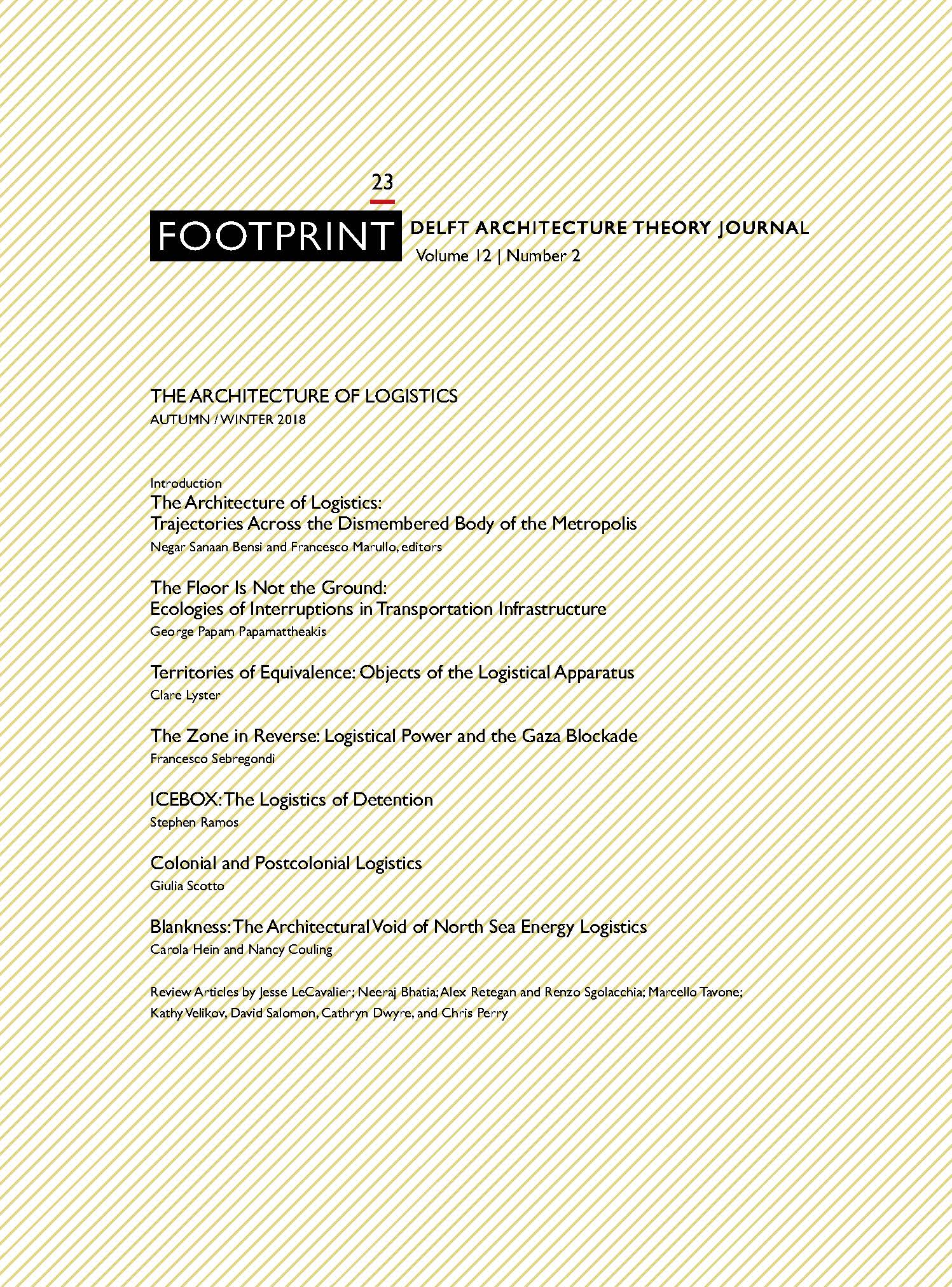Colonial and Postcolonial Logistics
DOI:
https://doi.org/10.7480/footprint.12.2.2044Abstract
This article addresses the logistical aspects of colonial and postcolonial governmental practices and the way in which such practices structured the African territory. In particular, it focuses on Zambia (Northern Rhodesia at time of British domination), a landlocked country located in the centre of Southern Africa, whose historical evolution, since it was conquered at the beginning of the twentieth century, is deeply intertwined with the discovery, extraction and export of copper and with the import of fossil fuel.
In the first part, I introduce the concept of ‘colonial logistics’ intended as the modification and rationalisation of territories for military and political domination, and extraction and export of resources. In the second part of the article I show how, after independence, Zambia dealt with its complex geopolitical entanglement, partially inherited from colonial planning and partially generated by the end of direct forms of imperialism, which required the rerouting of its resources and the rebalancing of uneven territorial structures. The analysis of infrastructure development in postcolonial Zambia illustrates the competing strategies through which imperialist powers attempted to secure a new form of control on Africa and elucidates the role of logistics as a decisive tool to shape the African territory.
References
Accorinti, Giuseppe. 2008. Quando Mattei era l’impresa energetica io c’ero. 3. ed. Matelica: Hacca.
Andrew D. Roberts. 1976. A History of Zambia. London: Heinemann.
Bailey, Martin. 1976. Freedom Railway: China and the Tanzania-Zambia Link. London: Rex Collings.
Bank, The World. 1966. “Zambia - Highway Reconstruction Project.” TO525. The World Bank. http://documents.worldbank.org/curated/en/721101468334889784/Zambia-Highway-Reconstruction-Project.
———. 1969. “Tanzania - Second Highway Project.” TO690. The World Bank. http://documents.worldbank.org/curated/en/837811468119658831/Tanzania-Second-Highway-Project.
———. 1976a. “Annexes.” 490. The World Bank. http://documents.worldbank.org/curated/en/305771468167969319/Annexes.
———. 1976b. “Main Text.” 490. The World Bank. http://documents.worldbank.org/curated/en/315711468166454706/Main-text.
———. 1976c. “Main Text.” 490. The World Bank. http://documents.worldbank.org/curated/en/315711468166454706/Main-text.
Bini, Elisabetta. 2013. La potente benzina italiana: Guerra Fredda e consumi di massa tra Italia, Stati Uniti e Terzo mondo (1945-1973). Roma: Carocci.
Cohen, Andrew. 2014. “Britain and the Breakdown of the Colonial Environment: The Struggle over the Tanzam Oil Pipeline in Zambia.” Business History Review 88 (4): 737–59. https://doi.org/10.1017/S0007680514000749.
Cooper, Frederick. 2002. Africa since 1940: The Past of the Present. New Approaches to African History. Cambridge: Cambridge University Press.
Easterling, Keller. 2014. Extrastatecraft: The Power of Infrastructure Space. London: Verso.
Gallagher, John, and Ronald Robinson. 1953. “The Imperialism of Free Trade.” The Economic History Review 6 (1): 1–15. https://doi.org/10.2307/2591017.
Gardiner, Robert K. A. 1973. “DISTANCE AND DEVELOPMENT.” Africa: Rivista Trimestrale Di Studi e Documentazione Dell’Istituto Italiano per l’Africa e l’Oriente 28 (1): 25–34.
Gewald, Jan-Bart. 2008. One Zambia, Many Histories: Towards a History of Post-Colonial Zambia. Vol. 12. Afrika-Studiecentrum Series. Leiden: Brill.
———. 2009. The Speed of Change: Motor Vehicles and People in Africa, 1890-2000. Vol. 13. Afrika-Studiecentrum Series. Leiden: Brill. http://sfx.metabib.ch/sfx_locater?sid=ALEPH:EBI01&genre=book&isbn=978-90-474-3079-7.
Gleave, M. B. 1992. “The Dar Es Salaam Transport Corridor: An Appraisal.” African Affairs 91 (363): 249–67.
Hance, William A., and Irene S. van Dongen. 1956. “The Port of Lobito and the Benguela Railway.” Geographical Review 46 (4): 460–87. https://doi.org/10.2307/212105.
Hansen, Karen Tranberg. 1997. Keeping House in Lusaka. New York: Columbia University Press.
Hecht, Gabrielle. 2011. Entangled Geographies: Empire and Technopolitics in the Global Cold War. Inside Technology. Cambridge, MA: MIT Press.
Kay, George. 1967. A Social Geography of Zambia: A Survey of Population Patterns in Developing Country. London: University of London Press.
Lunn, Jon. 1992. “The Political Economy of Primary Railway Construction in the Rhodesias, 1890-1911.” The Journal of African History 33 (2): 239–54.
Mbembe, Achille. 2013. “Necropolitics.” Public Culture 15 (1): 14–40.
Monson, Jamie. 2009. Africa’s Freedom Railway: How a Chinese Development Project Changed Lives and Livelihoods in Tanzania. Indiana University Press. https://muse.jhu.edu/book/3894.
Sachs, Wolfgang. 2010. The Development Dictionary: A Guide to Knowledge as Power. 2nd ed. London: Zed Books.
Shaw, Timothy M. 1982. “Beyond Neo-Colonialism: Varieties of Corporatism in Africa.” The Journal of Modern African Studies 20 (2): 239–61.
Simmance, Alan J. F. 1972. Urbanization in Zambia. An International Urbanization Survey Report to the Ford Foundation. https://eric.ed.gov/?id=ED079459.
Staples, Amy L. S., and Amy L. Sayward. 2006. The Birth of Development: How the World Bank, Food and Agriculture Organization, and World Health Organization Changed the World, 1945-1965. Kent State University Press.
“United Nations: Security Council Resolution Authorizing United Kingdom to Use Force to Prevent Oil Deliveries to Southern Rhodesia.” 1966. International Legal Materials 5 (3): 534–534.
Viganò, Paola. 1999. La città elementare. Milano: Skira.
Wallerstein, Immanuel Maurice. 2004. World-Systems Analysis: An Introduction. Durham: Duke University Press.
Westad, Odd Arne. 2005. The Global Cold War: Third World Interventions and the Making of Our Times. Cambridge University Press.
Downloads
Published
Issue
Section
License
- Authors retain copyright and grant the journal right of first publication with the work simultaneously licensed under a Creative Commons Attribution License that allows others to share the work with an acknowledgement of the work's authorship and initial publication in this journal.
- Authors are able to enter into separate, additional contractual arrangements for the non-exclusive distribution of the journal's published version of the work (e.g., post it to an institutional repository or publish it in a book), with an acknowledgement of its initial publication in this journal.





